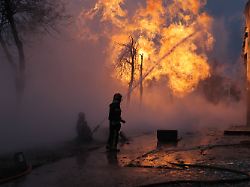For a long time, Ukrainian air defense had major problems with the Russian Kinschal missiles. That’s over, the supposed “miracle weapon” is not. However, the Kinschals fit well with the Russians’ attrition strategy.
Following Ukrainian airstrikes on targets in the Russian city of Belgorod on December 29th and 30th, Russia has increased its shelling of Ukraine. On Tuesday morning, the Russians were particularly targeting Kiev and the surrounding area as well as the city of Kharkiv. At least four Ukrainians died in the attacks.
And this despite the fact that the air defense was quite successful: the Ukrainian Air Force announced that 59 Ch-55 air-to-surface cruise missiles had been shot down, as well as three Kalibr guided cruise missiles and all ten Kinschal missiles. In total, the Russian army fired at least 99 missiles and numerous drones.
Russian leader Putin called the attacks on Belgorod an “act of terrorism” to which Russia would respond by “intensifying” attacks on military facilities in Ukraine. It is unclear whether Ukraine intended or accepted civilian casualties with its attacks on Belgorod; According to Russian information, 25 civilians were killed. What is certain, however, is that terror in this war comes solely from the aggressor. At least 39 people were killed in Ukraine on Friday alone.
“Then the rocket just glides”
What is remarkable about these attacks is not just how consistently Putin distorts the facts. It is also noteworthy that Ukraine was able to stop all Kinzhal rockets – according to Ukrainian commander Valeriy Zalushny a new record. This missile, which is fired from fighter jets, has been described as a “miracle weapon” in Russia – and in fact it initially caused great difficulties for the Ukrainian air defense system. Ukraine only reported the first shooting of a Kinschal in May 2023. The “dagger” – as “Kinschal” is called in German – is not a miracle weapon. But the type of rocket fits well with the Russians’ general attrition strategy, which relies on mass both when it comes to burning their own soldiers and their technology.
Kinschal missiles are slightly modified Iskander, a surface-to-surface missile with a range of up to 500 kilometers. Unlike these, Kinschal are fired by a MiG-31, says military expert Gustav Gressel from the European Council on Foreign Relations in Berlin to ntv.de. This makes it more difficult to intercept them. “It’s also harder to give advance warning because the thing comes in quicker.” The air alarm is already triggered in Ukraine when fighter jets of this type take off in Belarus. “The moment the missiles are fired from the fighter jet, it would be too late for protective measures,” said Gressel. “Then it only takes two to five minutes until impact.”
Kinschal missiles have a longer range than Iskander. But Gressel is skeptical about the top speeds of the alleged miracle weapon claimed by Russia: “It is a boost glide vehicle. That means: It accelerates very quickly, but then the rocket just glides because it has no drive of its own.” Since the tip of the rocket begins to glow after re-entering the Earth’s atmosphere, a plasma arc is created around the missile, which ensures that the Kinschal is initially difficult to detect by radar. “However, the Kinschal cannot maintain the high speed and thus the plasma arc.”
Not a hypersonic weapon
That’s why the Kinschal is not, as is often claimed, a hypersonic weapon, but rather the further development of a ballistic missile, emphasizes defense expert Nico Lange, Senior Fellow for the Turnaround Initiative at the Munich Security Conference. “The Kinschal flies very quickly and is difficult to fend off,” said Lange. “However, Ukraine shows that Patriot air defense systems can deter Kinschal missiles.” Ukraine even shot down waves of multiple rockets fired at the same time using Patriot anti-aircraft missiles. Long conclusion: “The Russian bohemianism surrounding Kinschal is not justified.”
Because the Kinschal flies faster than an Iskander, a Patriot air defense system must be closer to the missile’s target in order to be able to intercept it successfully, says Gressel. “But the thing can be intercepted, and the Ukrainians have the most war-proven and best air and missile defense in the world – after the Israelis, but perhaps also next to or even ahead of them.” Gressel, who worked in the Austrian Defense Ministry between 2006 and 2014, believes the Ukrainian Air Force’s kill numbers are plausible. “These are in line with the values that we calculated in simulations in the Federal Army back when the Kinschal was still being developed.”
“Central insight has still not reached decision-makers”
However, more than one Patriot missile is often needed to shoot down a Kinschal. “Often the time span in which such a missile can be intercepted is so short that you have to fire on suspicion. This drives up Ukraine’s ammunition consumption.” That’s the biggest problem with the Kinschals, says Gressel: “Procuring Patriots is difficult, the production times for these defense missiles are long. That’s the effect that Russia is counting on: that it produces more Kinschals than the West does Patriots.” Military expert Markus Reisner also points this out: “Russia is increasingly trying to oversaturate the anti-aircraft systems that the West has supplied. The goal behind this is to achieve constant wear and tear,” he says.
The question of who will win this industrial war of attrition will therefore not be decided in Ukraine, but in the western capitals. This central insight has not reached decision-makers in the West even almost two years after the start of the Russian attack on Ukraine: “This is also a war of the arms industries.”
